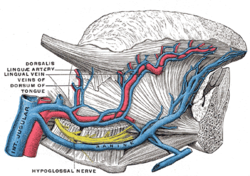- Lingual veins
-
Vein: {{{Name}}} Veins of the tongue. (Lingual vein labeled at left.) Latin vena lingualis ))))) Gray's subject #168 648 Drains from tongue Drains to internal jugular vein Artery lingual artery The lingual veins begin on the dorsum, sides, and under surface of the tongue, and, passing backward along the course of the lingual artery, end in the internal jugular vein.
The vena comitans of the hypoglossal nerve (ranine vein), a branch of considerable size, begins below the tip of the tongue, and may join the lingual; generally, however, it passes backward on the Hyoglossus, and joins the common facial.
The lingual veins are important clinically as they are capable of rapid absorption of drugs; for this reason, nitroglycerin is given under the tongue to patients suspected of having angina pectoris.
Tributaries
- Sublingual vein
- Deep lingual vein
- Dorsal lingual vein
- Suprahyoid vein
External links
- Photo of model (frog)
- Lingual+vein at eMedicine Dictionary
References
Moore NA and Roy W. Rapid Review: Gross Anatomy. Elsevier, 2010.
This article was originally based on an entry from a public domain edition of Gray's Anatomy. As such, some of the information contained within it may be outdated.
Veins (emissary, jugular and others) of head and neck (drainage patterns can vary) (TA A12.3.04–06, GA 7.644) External jugular DirectInternal jugular Superficial cerebral veins: superior · superficial middle · inferior · inferior anastomotic (Labbé) · superior anastomotic (Trolard)
Deep cerebral veins: great · internal (basal, deep middle, superior thalamostriate)To COSTo CSTo IJVDirectlingual (dorsal lingual, deep lingual, sublingual) · pharyngeal · superior thyroid (superior laryngeal) · middle thyroidBrachiocephalic DirectCategories:- Veins of the head and neck
- Cardiovascular system stubs
Wikimedia Foundation. 2010.

